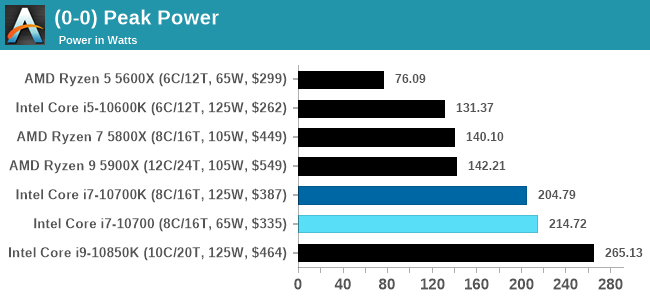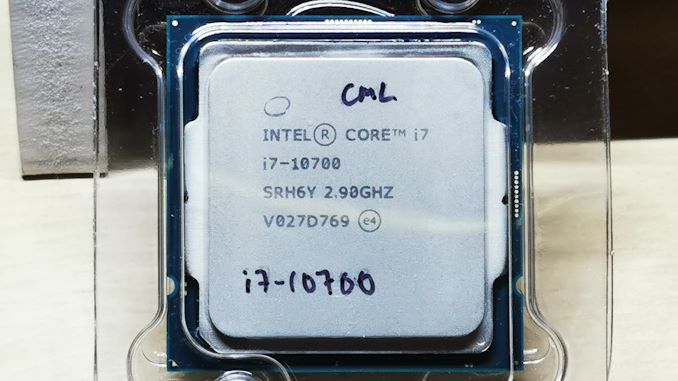Intel Core i7-10700 vs Core i7-10700K Review: Is 65W Comet Lake an Option?
by Dr. Ian Cutress on January 21, 2021 10:30 AM EST- Posted in
- CPUs
- Intel
- Core i7
- Z490
- 10th Gen Core
- Comet Lake
- i7-10700K
- i7-10700
Conclusion: TDP is Not Fit For Purpose
In years gone by, processors were sold with a single frequency and power rating. It was very quickly realized that if a processor could effectively go to sleep, using either lower voltage or lower frequency (or both) then a lot of idle power could be saved. Going the other way, processor designers realized that for temporary short bursts, a core could run at a higher frequency before it reached a thermal limit. Also, using a multi-core processor meant that either the power budget could be shared across all the cores, or it could be focused in one.
Both AMD and Intel have noticed this over time, and both companies have different attitudes on how they report numbers relating to ‘base frequency’ and related power as well as the bursty ‘turbo frequency’ and related power. Out of those four metrics, the only one Intel doesn’t provide is turbo power, because from their perspective it is system dependent.

Intel lets motherboard manufacturers determine how long a system can turbo for, and what that budget is. Intel encourages motherboard manufacturers to over-engineer the motherboards, not only for overclocking, but for non-overclockable CPUs to get the best performance for longer. This really messes up what the ‘default out-of-the-box performance’ should be if different motherboards give different values. The trend lately is that enthusiast motherboards enable an unlimited turbo budget, and the user building their system just has to deal with it.
This means that users who buy the Core i7-10700 in this review, despite the 65 W rating on the box, will have to cater for a system that will not only peak around 215 W, but sustain that 215 W during any extended high-performance load, such as rendering or compute. We really wished Intel put this 215 W value on the box to help end-users determine their cooling, as without sufficient guidance, users could be hitting thermal limits without even knowing why. At this point, 'Intel Recommended Values' for turbo time and budget mean nothing outside of Intel's own OEM partners building commercial systems.
Core i7-10700 vs Core i7-10700K Performance
In the review we highlighted that these two processors have a peak turbo frequency difference of 300 MHz and an all-core turbo frequency difference of 100 MHz. The fact that one is rated at 65 W and the other is rated at 125 W is inconsequential here, given that most end-user motherboards will simply enable turbo all the time. This means the performance in most of our tests between the two is practically identical, and consummate to a 100-300 MHz frequency difference.
In practically all of our tests, the Core i7-10700K is ahead by a super slim margin. At $387 for the 10700K compared to $335 for the 10700, the performance difference is not enough to warrant the $52 price difference between the two. Performance per dollar sides mostly with the Core i7-10700, although users getting the i7-10700K will likely look towards overclocking their processor to get the most out of it – that ultimately is what to pay for.
The other comparison point is with the Ryzen 5 5600X, which has two fewer cores but costs $299. In practically every test, the increased IPC of the Ryzen over Intel means that it sits identical with the Core i7 processors, AMD is cheaper on list price, and at a much lower power (AMD will peak around 76 W, compared to 215 W). AM4 motherboards are also abundant, while corresponding Intel motherboards are still expensive. The problem here however is that AMD is having such high demand for its product lines right now that finding one in stock might be difficult, and it probably won’t be at its recommended price.
Users in this price bracket have a tough choice – the more efficient AMD processor that might be in stock, compared to the Intel processor that will be in stock but more cooling will likely be required.











210 Comments
View All Comments
Spunjji - Friday, January 22, 2021 - link
You can infer temperature from wattage more accurately than via a temperature measurement, because that measurement depends on the configuration of the test system (cooler type, fan speeds, case airflow).Hxx - Friday, January 22, 2021 - link
thats not true because its not proportional with power draw. A 10700k uses 200+W and runs at around 70C while a 5600x uses much less power running at around the same temps. Power draw is not a good indicator and yes it comes down to your setup. Intel is just not as efficient but doesnt make it a hot chip.Oxford Guy - Sunday, January 24, 2021 - link
Yes, it does. That heat doesn't vanish into thin air. It exists.Spunjji - Monday, January 25, 2021 - link
"A 10700k uses 200+W and runs at around 70C"Again, with what cooler and fan speeds? Even accounting for the different die sizes, the only way this comparison can really be true is if there isn't an equal amount of cooling between the two processors. As OxfordGuy said, that heat has to go *somewhere*; for the temperatures to be the same between different heat loads *something* must be causing more heat to be dissipated.
vegemeister - Sunday, January 24, 2021 - link
No. IIRC all of the K variants have soldered IHS and shaved down dies. Not all of the non-K products do.Spunjji - Monday, January 25, 2021 - link
That's a point I had forgotten, and a fair one - but temps in a review still won't tell an end-user much about the temps they'll get, especially as variability can be quite high depending on the voltage an individual CPU requires to operate at its various speeds.dsplover - Friday, January 22, 2021 - link
Nobody wants Intel until they ditch 14nm. I love Intel, but I’m getting their next CPU, as well as a desktop AMD 5000 w/APU.Seems they survived their diversity exercises and are back in the game, but not until 2022.
Until then a few 4790k’s are still paying me.
Spunjji - Monday, January 25, 2021 - link
"Seems they survived their diversity exercises"Intel are doing badly, it MUST be because they stopped almost exclusively hiring white men! /s
Motivated reasoning is a disease.
Hixbot - Saturday, February 13, 2021 - link
Wow, you're really pinning Intel's faults on diversity? Meanwhile you are ignoring AMDs success is lead by an Asian American woman? You really need to check your bigotry at the door.Oxford Guy - Friday, January 22, 2021 - link
‘Specifically on the sha256 tests, both AMD and Via pull out a lead due to a dedicated sha256 compute block in each core.’VIA, eh?